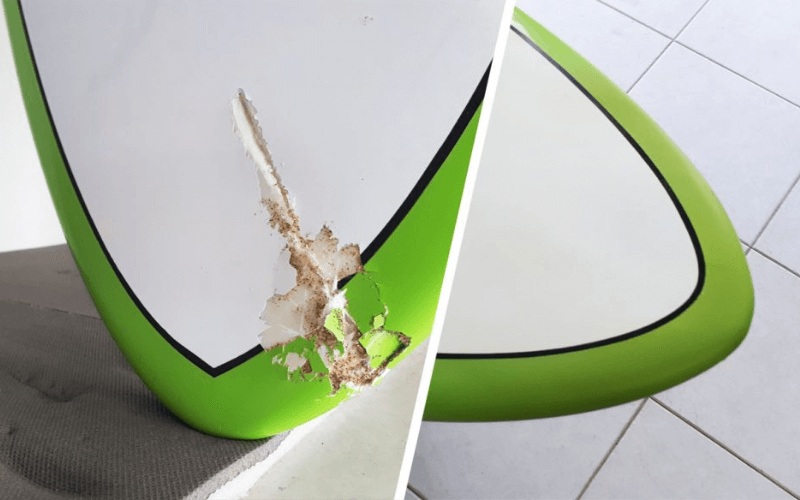If you are a surfer, then you know that dings happen. And when they do, it’s important to know how to fix them quickly and easily.
In this post, we’ll show you how to fix surfboard dings using a few simple tools and techniques. So whether you’re at the beach or in your workshop, you’ll be able to take care of those pesky dings in no time!
How to fix surfboard dings?
When you notice a ding or crack in your surfboard, it is important to take action right away. Taking action right away is key to preventing further damage and ensuring that you can enjoy many years of safe and fun surfing adventures.
There are several steps you can take to fix dings and cracks, depending on the severity of the damage.
- First, start by carefully removing any loose debris or other materials that may be present in the ding. This can be done using sandpaper or a sander to smooth out the area around the ding.
- Once this is done, apply a layer of epoxy resin over the damaged area and let it dry completely before repeating it if necessary.
- Next, use fine-grit sandpaper or another abrasive material to smooth out the repaired area and wipe away any excess resin using a clean towel or rag.
- Be sure to take care of your repaired surfboard by rinsing it off with fresh water after use and storing it in a dry, covered location when not in use. With proper care, your repaired surfboard should last for many years to come.
- If there are more severe dings or cracks in your surfboard, you may need to seek professional help.
How to identify a ding?
Several different signs can indicate you have a surfboard ding are:
1. Bubbles in the board:
If you see small bubbles forming on the top of your surfboard, then this is likely a ding. Such bubbles often form as a result of impacts with rocks or other hard surfaces beneath the water.
2. Cracks in the board:
If you notice cracks forming in your surfboard, especially if they seem to be growing over time, this could be another sign of a ding.
This may be caused by repeated impacts and shocks to the board.
3. Water leaking into the board:
If you notice that your surfboard has started to take on water when it’s out of the water, then this is also an indication that there’s been some kind of damage done to it.
This can happen if there are any cracks or holes in your board that have allowed water to seep in.
4. Discoloration:
If you notice any discoloration on your surfboard, especially if this seems to be concentrated in a particular area, it could be an indication that there’s been some damage done.
5. Reduced performance:
If your surfboard suddenly starts to seem less responsive or you are having difficulty controlling it, this could be another sign of a ding. Often these issues will only become noticeable once you’re out on the water and amid rolling waves.
If you notice any of these signs, it’s important to take action as soon as possible.
What to use to fix a ding?
There are several different options for repairing a surfboard ding.
- Use a surfboard repair kit: The most common method is to use a surfboard repair kit, which contains all of the necessary tools and materials for repairing a damaged board.
- Heat gun: Another option is to use a heat gun or hair dryer to soften the damaged area so that you can press a new piece of fiberglass material into place.
- Use sandpaper: If the damage is minor, you might be able to repair it simply by lightly sanding down and fixing the edges of the damaged area.
- Use epoxy resin: If the damage is more extensive, you might need to use epoxy resin or another type of fiberglass repair compound to fill in the damaged area and create a smooth surface.
- Call a professional: Finally, if you are not comfortable attempting to fix your board, you can always call a professional surfboard repair service.
How to fix a ding with surfboard resin?
Surfboard resin is a strong adhesive often used to repair dings on surfboards. Fixing a ding with surfboard resin is relatively easy and can help prevent the board from cracking.
First, use a flathead screwdriver to remove any excess debris or loose pieces of resin from the ding.
Next, apply a small amount of resin into the hole using your finger or an applicator brush. Use gentle pressure until the surface feels smooth and even and allow it to dry completely, then add another layer or two of resin and finish with a coat of wax to seal in your repair.
If you’re not comfortable fixing dings on your own, consider taking it to a professional who can complete this task for you quickly and easily.
How to fix a ding with fiberglass cloth and resin?
One of the easiest ways to fix a ding or small hole in your board is to apply a layer of fiberglass cloth directly over the damaged area. To do this, start by cleaning and lightly sanding the affected area so that it is smooth and free of any debris or rough edges.
Next, cut a piece of fiberglass cloth that is large enough to cover the entire damaged area. You may need to overlap the edges slightly for complete coverage.
Then, apply a thin resin layer over the surface using a brush or roller. Once the resin has dried, use sandpaper or a sander to smooth out any remaining bumps or irregularities.
If you are still experiencing any issues, you may need to repeat this process a few times until the ding is fully repaired. Although repairing a ding on your surfboard can be a bit time-consuming and tedious, with the right tools and techniques it is possible.
How to fix a ding with epoxy putty?
There are several steps that you can follow to fix a surfboard ding with epoxy putty.
- First, thoroughly clean the damaged area of your surfboard.
- Next, mix the epoxy putty according to the manufacturer’s instructions and carefully apply it over the damaged area with an appropriately sized putty knife. Smooth out the surface of the epoxy putty as you work, then allow it to dry completely before sanding and polishing it for a seamless finish.
- Finally, seal and waterproof your repaired board by applying a layer of marine-grade surfboard wax or varnish over the area.
If you follow these steps carefully, you should be able to fix your surfboard ding and get back out on the waves in no time.
How to fix a ding with marine-grade epoxy?
If your surfboard has sustained damage from wear and tear or impact, repairing it with marine-grade epoxy can help restore its structural integrity and performance.
- Clean the area around the ding with warm soapy water and a soft cloth, to remove any dirt or debris. Allow the surface to dry completely before proceeding.
- Mix a small amount of marine-grade epoxy, if working with two-part epoxy, begin by dispensing equal amounts of each component into separate mixing containers. Use a stir stick or other mixing tool to thoroughly combine the two components until they are fully blended, uniform in consistency and free of clumps.
- Apply a thin layer of epoxy to the damaged area using a foam brush, taking care to fill any cracks or gaps as you go. Allow the epoxy to cure for at least 24 hours before using your surfboard again.
- If necessary, repeat steps 2-3 until all damage has been repaired and your surfboard looks like new again.
Be sure to apply a waterproof sealant over the repaired area when you are finished, to protect it from future damage.
FAQs – How to fix surfboard dings
Can you get dents out of a surfboard?
Yes, it is possible to get dents out of a surfboard. There are a variety of methods you can try depending on the severity and location of the dent.
For minor dents, some people recommend using a hairdryer or hot water bottle to heat the area and loosen up the dent. You could also try gently tapping on the surface of the board with a wooden mallet or another tool to help push out the dent from the inside.
For more severe dents, you may need to take your board to a professional repair shop. Regardless of which method you choose, always be sure to take good care of your surfboard.
How do you fix a surfboard nose ding?
There are a few different ways to fix a surfboard nose ding, depending on the size and type of board that you have.
- One common method is to use an epoxy filler stick, which can be easily applied directly onto the damaged area.
- Another option is to use a special type of resin that provides additional strength and durability to the board.
- Finally, some surfers recommend using super glue or duct tape as a last resort approach for fixing small dings in your surfboard’s nose.
- Ultimately, the best way to repair a nose ding will depend on your specific needs and preferences.
What is Q cell filler?
Q cell filler is a type of epoxy resin used to repair damaged areas on surfboards and other types of water-based equipment.
This type of filler provides high levels of durability and strength, making it ideal for repairing dings, cracks and further common damage in surfboards and other water gear.
Q cell filler can be applied directly onto the damaged area using specialized tools or techniques, depending on the size and complexity of the damage.
It is also sometimes combined with other materials such as fiberglass or heat-resistant resins to create an even stronger repair solution.
Overall, Q cell filler is one of the most popular options for repairing damage in surfboards and other water sports equipment.
Wrap Up:
You can now go out and confidently fix any surfboard dings that come your way. Smaller ones can be fixed with a hairdryer and bigger ones will need some patching.
With these tips, you’ll be back in the water in no time! Just remember to take your time, use the right tools for the job and be as gentle as possible while sanding away the ding.
For more tips on surfing and maintaining your board, check out our blog. We update it regularly with new posts about all things surfing!





